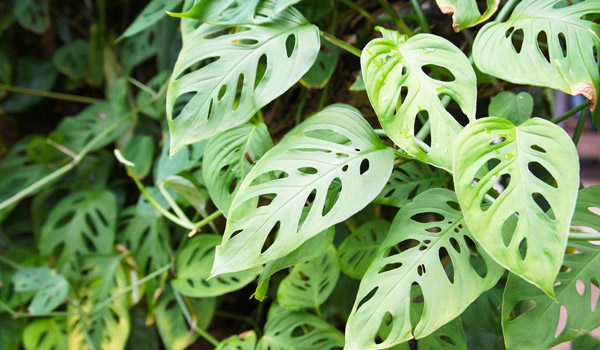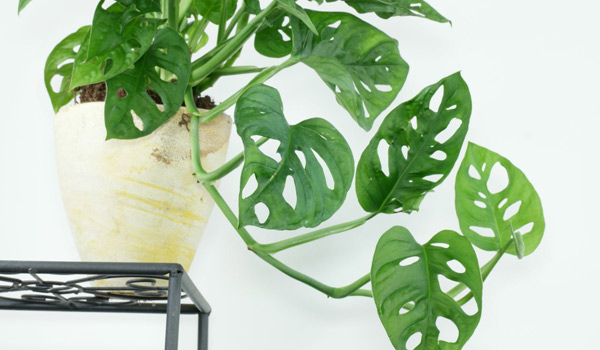Swiss Cheese Plant Care Guide (Monstera Adansonii)

At the first glance, you may think there is something wrong with the Swiss cheese plant, that its heart-shaped leaves had lost a war against pests. But these holes are naturally developed during fenestration as the plant ages, and it is because of them that we call it by this name.
Scientifically known as Monstera Adansonii, the Swiss cheese plant originally comes from Central and South America. Due to its vining habit and fast growth rate, this tropical perennial is a very popular houseplant. Scroll down for brief information about types of Swiss cheese plants, their benefits, and a full guide for its care.
Types of Swiss Cheese Plant
Also known as the Swiss cheese vine and five holes plant, this plant (as well as its other types) is suitable to grow both indoors and outdoors. However, you need to be careful when growing them, as all parts of types of Swiss cheese plant are toxic to pets.
When grown outside, it can grow up to 10 to 13 feet in height and produces beautiful white blooms in spring. When grown indoors, it grows to a manageable size of 1 to 3 feet tall, but will not be able to flower. In addition to its Swiss cheese leaves, this plant has another unique feature as well: aerial roots.
They grow downward from the stem and brace against the ground and other available supports including adjoining trees or woody vines in the wild, and a stake in the center of its pot indoors. With that being said, these are the important types of the Swiss cheese vine:
Monstera Deliciosa
Monstera Adansonii is not the only plant that goes by the common name of Swiss cheese plant. There is also Monstera Deliciosa, its cousin that simply features larger leaves than the original plant.
Monstera Borsigiana
Despite Monstera Deliciosa, this is a smaller variety that grows at a faster rate. To identify this sub-specie, check the top of the mature leaves and where they meet the stem. There, Deliciosa has a wrinkle while the Borsigiana does not.
Monstera Obliqua
This rare species is quite similar to Monstera Adansonii, but you can always recognize it by its thinner leaves that have more holes in them.

Swiss Cheese Plant Care
This plant and its varieties such as Monstera Adansonii may not be succulent, but they are surprisingly easy to care for. This plant actually can grow happily when its basic requirements are provided. To have the most vibrant plant with your preferred size, this is how you should care for this charming species:
Light
Swiss cheese plant light should be bright and indirect. Considering that this is a tropical plant and it originally thrives under the cover of large trees in the jungle, do not let your plant receive more than two or three hours of direct sunlight as they easily burn.
Water
Considering their natural habitat, it is no surprise that their soil should be consistently moist. However, these gorgeous species do not like soaked soils, so before watering, always check the potting mix by sticking your finger into the soil about an inch deep.
If the soil feels nearly dry, water your Swiss cheese plant until you see a little water running out of the drainage holes.
Soil
Monstera adansonii and other types of this plant love potting soils with an acidic and neutral PH between 5.5 and 7. To guarantee its strong and healthy growth, choose a peat-based potting mix, which traps the moisture in the soil without waterlogging it with the mentioned PH.
Temperature
Temperatures between 65 to 80 degrees Fahrenheit are ideal for the Swiss cheese vine. To make things simple, remember this: keep your plant in a spot that is above 40 degrees Fahrenheit all the time. Temperatures below 65 degrees Fahrenheit will slow down its growth while below 50 degrees Fahrenheit will stop its growth completely. Also, protect it from drafts.
Humidity
Jungles are humid. So the perfect spot for your Swiss cheese plant would be a warm and bright bathroom that mimics its natural conditions. This plant requires average to high room humidity, above 50% is ideal. So if there is not a space for your plant in the bathroom, you will need to increase the humidity of a normal room using a humidifier or misting the leaves.

Potting and Repotting
Monstera adansonii accepts all containers with drainage holes, whether you are going to put them on the ground or in hanging baskets (which looks really eye-catching by the way). To pot a nursery five holes plant, choose a container that is slightly larger than its root ball. Place the plant as deep as it was in the nursery container, and fill it with a suitable potting mix. Keep in mind to repot it every two years as well as changing it with fresh potting mix.
Tip: The best time for potting and repotting this plant is in the spring.
Fertilizer
In Swiss cheese plant care, after potting/repotting it, you need to wait at least four to six months before fertilizing it. This is because the potting mix already has slow-release fertilizer in it most of the time. After this time, you can feed the plant every month using an all-purpose liquid fertilizer diluted by half.
Pruning
Depending on its location and your preference, the Swiss cheese plant vine needs to be pruned from time to time. Similar to potting and repotting, we suggest pruning this plant in the spring too.
Prepare a sterile pruning shear and cut the stems back by no more than 25 percent just before the Swiss cheese plant node. While doing that, do not forget to cut dead or/and damaged leaves too.
Pests and Diseases
Swiss cheese plant care is convenient, but it is not bulletproof when it comes to some of the common houseplant pests such as mealybugs, spider mites, scale, and whitefly. These pests are not typically fatal, and you can treat those using nontoxic insecticides or neem oil if you act soon enough.
In addition to pests, beware of common diseases including root rot, rust, powdery mildew, and blight. Let us take a look at the signs of some of these problems for better Swiss cheese plant care:
- Yellow Leaves: If the monstera adansonii leaves are turning yellow, it means that you are overwatering the plant. Do not water your plant so much that it sits in soggy soil, and let the soil slightly dry out between irrigations.
- Black Marks: If the leaves are showing black marks, it can indicate leaf burn from direct sunlight. No matter what types of Swiss cheese plant you have, do not let the direct sun hit it for very long and especially protect it from the strong afternoon sun.
- Lack of Holes: Your plant’s leaves do not form slits or holes? This can be a sign of very low Swiss cheese plant light, water, or fertilizer. If you have a tall monstera adansonii, we recommend checking to see if the aerial roots are in compost. If not, then place them in soil or on a moist moss pole.

Swiss Cheese Plant Benefits
With proper Swiss cheese plant care, you will not simply have a gorgeous plant with unique leaf patterns in your home or office. This plant has other benefits too. For example, it purifies the air and helps in humidifying air conditions.
Also, if you grow it outside, you can eat its fully ripen fruits that are rich in vitamin C. They also have proteins, vitamin B, calcium, phosphorous, while having zero (not ripened fruits can be poisonous). Swiss cheese plant benefits include curing diseases like arthritis and insect or snake bites as well.
How to Propagate Swiss Cheese Plant
Cultivating aside, which is usually done by young nursery plants, there are two ways to propagate monstera adansonii:
Using Stem Cuttings
This is the easiest and the most inexpensive way to get new plants since it allows you to use the stems that are removed while pruning. Wait for the spring and then follow these steps:
- Cut a 4 to 6 inch stem just after a Swiss cheese plant node. Remove the leaves on the bottom third to half of the cutting.
- Apply rooting hormone to the cut end, and plant it in a moist soilless potting mix in a small container that has drainage holes.
- Place the container in a warm spot with bright, indirect light and keep the soil lightly moist.
In a few months, you will notice well-formed roots and you will be able to plant the cutting in a larger pot.
Using Seeds
Growing monstera adansonii from seeds is more challenging, but still possible. You will need to:
- Plant them in a shallow tray filled with moist seed-starting mix, covering the seed lightly with the mix.
- Put plastic wrap over the tray to keep the growing medium moisture, and place it in a warm location with bright, indirect light.
- Mist the seed-starting mix to keep it lightly moist.
The five holes plant’s seeds should germinate in a few weeks. When that happens, remove the plastic wrap, but keep misting the growing medium. After a few months, the young seedlings should be large enough to be transferred into small containers.
Do You Have a Monstera Adansonii?
This is a truly charming plant to grow indoors and outdoors. Have you ever had a Swiss cheese plant? Was it as convenient as you thought or did you have some challenges? Tell us about your unique experience and let us and other readers know in the comments section below.
- In this post:
- Types of Swiss Cheese Plant
- Swiss Cheese Plant Care
- Swiss Cheese Plant Benefits
- How to Propagate Swiss Cheese Plant
- Do You Have a Monstera Adansonii?



